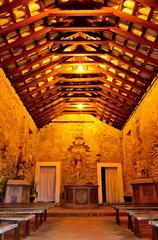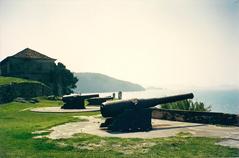
Forte de Santana do Estreito: Visiting Hours, Tickets, and Historical Significance in Florianópolis
Date: 04/07/2025
Introduction
Forte de Santana do Estreito, nestled in the vibrant city of Florianópolis, Brazil, stands as a living monument to the island’s colonial military past. Built between 1761 and 1763, this fortification was integral to the defense of Santa Catarina Island, safeguarding the former settlement of Nossa Senhora do Desterro—modern-day Florianópolis—by overseeing critical maritime passages. Today, the fort seamlessly blends its rich heritage with a dynamic cultural presence, offering visitors a unique window into Brazil’s historical and architectural legacy, panoramic views of the Hercílio Luz Bridge, and a host of educational and leisure activities. For comprehensive visitor details and up-to-date planning resources, consult the Florianópolis Tourism Website, the Military Police of Santa Catarina Museum page, and the Prefeitura de Florianópolis.
Table of Contents
- Introduction
- Historical Overview
- Decline and Restoration
- Contemporary Significance
- Visiting Information
- Visitor Experience Highlights
- Practical Tips for Visitors
- Nearby Attractions
- Frequently Asked Questions
- Visuals and Media
- Related Articles
- Conclusion
- References
Historical Overview
Colonial Foundations and Strategic Purpose
Forte de Santana do Estreito was constructed as part of a comprehensive defense system for the island of Santa Catarina. Designed by Lieutenant Colonel José Custódio de Sá e Faria and executed under Colonel Francisco Antônio Cardoso de Meneses e Sousa, the fort’s location atop Rita-Maria hill was chosen for its strategic vantage point at the narrowest crossing between island and mainland. Its irregular hexagonal stone and limework layout enabled effective control over vital waterways, deterring invasions and protecting the emerging city.
Architectural Features and Defensive Capabilities
The fort’s robust walls—measuring up to 1.2 meters thick—encompass a bastioned perimeter with sentry boxes overlooking the Baía Norte. Originally equipped with nine artillery pieces, Forte de Santana could command both maritime and land approaches. The fortification’s architectural integrity, characterized by its Luso-Brazilian military style, remains a remarkable example of 18th-century engineering.
Military Role and Evolution
Throughout the 18th and 19th centuries, the fort played a pivotal role in regional defense, later adapting to house a naval apprentice school and a police station. Its artillery, garrison, and functions evolved in response to shifting military technologies and administrative needs. The fort’s role diminished with the advent of modern infrastructure, such as the Hercílio Luz Bridge, and was decommissioned as a defensive structure in 1907.
Decline and Restoration
Following its decommissioning, Forte de Santana fell into neglect until it was declared a national heritage site in 1938. Restoration efforts led by IPHAN (Instituto do Patrimônio Histórico e Artístico Nacional) in the late 1960s and early 1970s revived the site, restoring its colonial character and adapting it for educational and cultural uses. Recent revitalization projects—most notably in 2022—have further improved accessibility and transformed the surrounding area into a public plaza, ensuring the fort’s preservation and ongoing relevance.
Contemporary Significance
Today, Forte de Santana houses the Museu de Armas Major Antônio de Lara Ribas, managed in partnership with the Military Police of Santa Catarina. The museum curates an impressive collection of historical weapons, uniforms, and military artifacts, offering insight into the region’s defense history. The fort also serves as a venue for cultural events, educational programs, and community gatherings, cementing its role as both a historical monument and a vibrant public space.
Visiting Information
Opening Hours
- Tuesday to Sunday: 9:00 AM – 5:00 PM
- Closed: Mondays and public holidays
- Note: Some events may affect opening times; always check the official website for updates.
Tickets
- Admission: Free for all visitors
- Donations: Welcome to support preservation efforts
Location and Access
- Address: Avenida Beira-Mar Norte, 1400, Ponte Hercílio Luz, Florianópolis, SC, 88010-150
- By Car: On-site and nearby street parking available
- By Public Transport: Adjacent to the Rita Maria Bus Station; several city bus lines stop nearby
- By Bicycle: Cycle paths and bike racks are provided
- On Foot: Easily accessible from downtown hotels and attractions
Accessibility
- Recent Improvements: Ramps, improved pathways, and accessible restrooms accommodate visitors with reduced mobility
- Note: Some upper bastions remain challenging due to the original construction. Staff assistance is available upon request
Guided Tours
- Availability: Offered weekends and by appointment on weekdays
- Booking: Recommended via the official tourism website
- Language: Guided tours generally in Portuguese; bilingual signage is present
Visitor Experience Highlights
Scenic Views and Photography
The fort’s ramparts provide sweeping views of Baía Norte and the Hercílio Luz Bridge, making it one of Florianópolis’s premier photo spots—especially at sunset.
Family-Friendly Features
Open courtyards and grassy areas are ideal for families. The museum’s educational displays engage visitors of all ages, and school groups frequently visit for tailored programs.
Cultural Events
Forte de Santana is a hub for local culture, hosting craft fairs, music performances, historical reenactments, and the annual Dia Municipal da Baleeira (December 18th), celebrating the region’s whaling heritage.
Practical Tips for Visitors
- Best Time to Visit: Early mornings and late afternoons for cooler temperatures and optimal lighting
- Duration: Allow 45–90 minutes for the fort and museum
- What to Bring: Comfortable shoes, sun protection, water, and a camera
- On-Site Amenities: Restrooms, shaded seating, and a souvenir kiosk; café opening soon
- Food: No on-site restaurant yet—plan to dine at nearby establishments
Nearby Attractions
- Hercílio Luz Bridge: Pedestrian walkway and historic landmark
- Parque da Luz: Urban green space ideal for walks
- Downtown Florianópolis: Historic center, Mercado Público, and cultural venues
- Other Forts: Forte de São José da Ponta Grossa and other colonial sites
Frequently Asked Questions (FAQ)
Q: Is admission to the fort free?
A: Yes, entry is free for all visitors.
Q: What are the opening hours?
A: Tuesday to Sunday, 9:00 AM to 5:00 PM; closed Mondays and public holidays.
Q: Are guided tours available?
A: Yes, on weekends and by appointment; advance booking recommended.
Q: Is the site accessible to visitors with disabilities?
A: Most areas are accessible; some upper sections may be challenging.
Q: Can I bring my pet?
A: Leashed pets are allowed in outdoor areas; not inside museum rooms.
Q: Where can I park?
A: On-site and nearby street parking is available.
Q: Are food and restroom facilities available?
A: Restrooms are on-site; a café is planned—bring your own snacks for now.
Visuals and Media
- Virtual Tour of Forte de Santana do Estreito
- For more images and virtual experiences, visit the official museum site and local tourism portals.
Related Articles
- Top Historical Sites to Visit in Florianópolis
- Exploring the Hercílio Luz Bridge: History and Highlights
- Family-Friendly Attractions in Florianópolis
Conclusion
Forte de Santana do Estreito offers a captivating blend of military history, cultural activities, and breathtaking scenery. Free to visit, with ongoing accessibility improvements and a calendar full of engaging events, the fort is a must-see for anyone in Florianópolis. Plan your visit using the Audiala app for guided tours and up-to-date information, and follow local tourism channels for news on special events. Immerse yourself in the rich heritage of Santa Catarina and create lasting memories at this iconic historical site.
References
- Visiting Forte de Santana do Estreito: History, Tickets, and Travel Tips in Florianópolis, 2025 (https://www.visitfloripa.com.br)
- Forte de Santana Visiting Hours, Tickets, and Cultural Guide to Florianópolis Historical Site, 2025 (https://www.pmf.sc.gov.br)
- Visiting Forte De Santana Do Estreito: Hours, Tours, and Travel Tips for Florianópolis’ Historic Fort, 2025 (https://turismo.florianopolis.sc.gov.br/)
- Practical Tips for Visitors, 2025 (https://en.guiafloripa.com.br/tourism/strengths/fort-of-santana-do-strato)
- Official Florianópolis Tourism Website
- IPHAN - Instituto do Patrimônio Histórico e Artístico Nacional
- Guia Floripa - Forte de Santana
- Praias Florianópolis - Forte de Santana
- ND Mais - Forte de Santana
- TripAdvisor - Forte Santana do Estreito









